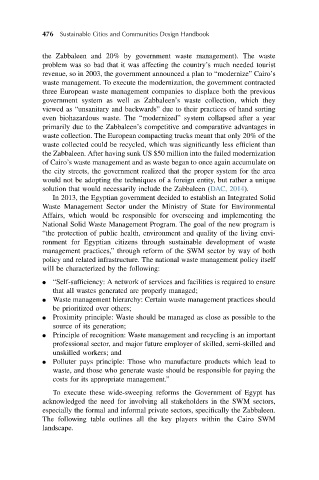Page 506 - Sustainable Cities and Communities Design Handbook
P. 506
476 Sustainable Cities and Communities Design Handbook
the Zabbaleen and 20% by government waste management). The waste
problem was so bad that it was affecting the country’s much needed tourist
revenue, so in 2003, the government announced a plan to “modernize” Cairo’s
waste management. To execute the modernization, the government contracted
three European waste management companies to displace both the previous
government system as well as Zabbaleen’s waste collection, which they
viewed as “unsanitary and backwards” due to their practices of hand sorting
even biohazardous waste. The “modernized” system collapsed after a year
primarily due to the Zabbaleen’s competitive and comparative advantages in
waste collection. The European compacting trucks meant that only 20% of the
waste collected could be recycled, which was significantly less efficient than
the Zabbaleen. After having sunk US $50 million into the failed modernization
of Cairo’s waste management and as waste began to once again accumulate on
the city streets, the government realized that the proper system for the area
would not be adopting the techniques of a foreign entity, but rather a unique
solution that would necessarily include the Zabbaleen (DAC, 2014).
In 2013, the Egyptian government decided to establish an Integrated Solid
Waste Management Sector under the Ministry of State for Environmental
Affairs, which would be responsible for overseeing and implementing the
National Solid Waste Management Program. The goal of the new program is
“the protection of public health, environment and quality of the living envi-
ronment for Egyptian citizens through sustainable development of waste
management practices,” through reform of the SWM sector by way of both
policy and related infrastructure. The national waste management policy itself
will be characterized by the following:
l “Self-sufficiency: A network of services and facilities is required to ensure
that all wastes generated are properly managed;
l Waste management hierarchy: Certain waste management practices should
be prioritized over others;
l Proximity principle: Waste should be managed as close as possible to the
source of its generation;
l Principle of recognition: Waste management and recycling is an important
professional sector, and major future employer of skilled, semi-skilled and
unskilled workers; and
l Polluter pays principle: Those who manufacture products which lead to
waste, and those who generate waste should be responsible for paying the
costs for its appropriate management.”
To execute these wide-sweeping reforms the Government of Egypt has
acknowledged the need for involving all stakeholders in the SWM sectors,
especially the formal and informal private sectors, specifically the Zabbaleen.
The following table outlines all the key players within the Cairo SWM
landscape.

